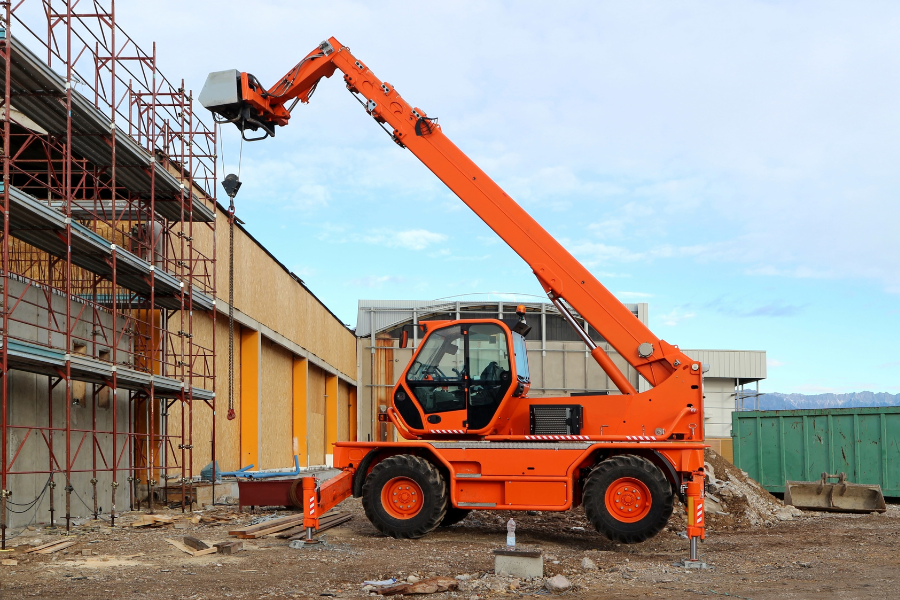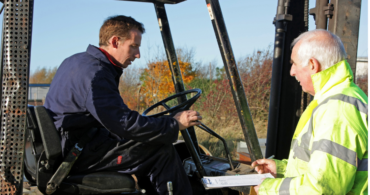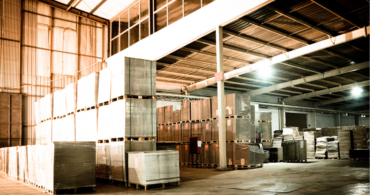In this corner, weighing on average 3,000-5,000 pounds, the lean, mean lifting machine: forklift. In the opposite corner, weighing on average 20,000-25,000 pounds, the versatile vehicle that brings the boom: telehandler.
Welcome to the first in our rock ‘em, sock ‘em series comparing the lifting machines we all love. (This article on stand-up vs sit-down forklifts is also a great resource, but it doesn’t flow like it should be read in Michael Buffer’s voice.)
Alright, the machines have shaken hand-like attachments, and we’re ready to begin.
Round 1 Telehandler vs forklift: What are they?
What is a forklift?
We must start by acknowledging that both vehicles discussed in this article fall under the seven classifications of forklifts. However, the one that most people picture when they hear the term “forklift” is the counterbalanced forklift.
Counterbalanced forklifts typically have four wheels (although some have three) that are either cushion (solid) or pneumatic (air-filled). The vehicle’s most prominent feature is the forks attached to a mast at the front of the truck.
What is a telehandler forklift?
Also known as a telelift forklift or telescopic forklift, a telehandler is a highly versatile piece of construction equipment.
A forklift telehandler features a cab that kind of looks like half of a dune buggy (cut down the middle) plopped on top of an industrial vehicle. Its four wheels are typically pneumatic and designed for rugged terrain. Its most prominent feature is the telescoping arm, or boom, attached to the vehicle’s rear.
The boom is the reason for the telehandler’s unusual, half-dune buggy appearance. When it is not in use, the forklift telescopic boom rests beside the cab along the length of the vehicle.
Round 2 Telehandler vs forklift: How do they work?
How does a counterbalanced forklift work?
Counterbalanced lift trucks have forks attached to a vertical mast, allowing them to lift and move heavy loads. In some instances, the mast can tilt slightly forward and backward.
The term “counterbalanced” refers to the heavy battery that powers the forklift and additional counterweights in the vehicle’s rear that keep the truck level while lifting and moving. The lift truck’s three-point suspension system also helps to distribute the weight.
How does a telehandler work?
A telehandler forklift uses its boom to lift and move heavy objects. Have you seen the movie “Aliens?” At one point, the main character operates a mechanized exoskeleton in a warehouse. The arms on that suit are fancy, space-like versions of a telehandler’s boom. The boom can move up, down, left and right, tilt forward, backward and side-to-side, and extend typically as much as 30 feet (some models can go further) and up to a 70-degree angle.
Telescopic handler forklifts are sometimes described as a combination of a crane and a forklift. However, this extensive versatility and range of movement come at a cost. The ingenious design of a counterbalanced forklift is not enough for a forklift telescopic handler. Even with counterweights in the rear, the boom’s left and right movement alone is enough to upset its center of balance. Instead, a telehandler uses sensors to monitor the load, warn an operator when the vehicle has exceeded its lifting capabilities and cut off the controls to help prevent accidents. Some telehandlers also have hydraulic front stabilizing legs, known as outriggers, that prevent movement and provide additional balance.
Round 3 Telehandler vs forklift: Where do they work?
Where do counterbalanced forklifts operate?
Most counterbalanced forklifts are compact and designed to navigate the tight turns and narrow aisles of modern warehouses. Also, their three-point suspensions, rear-wheel steering and cushion tires are intended for the smooth, paved surfaces of warehouse docks and floors. Uneven surfaces and rough terrains are not friends to these vehicles. As such, most counterbalanced forklifts are used to move cargo in and out of 18-wheelers and storage racks.
However, don’t let this fool you into thinking that counterbalanced forklifts are one-note machines. Counterbalanced forklifts are incredibly versatile. They can be fitted with various attachments (to carry barrels, lumber, etc.) and safely lift thousands of pounds (always check a forklift’s data plate to confirm the vehicle’s maximum carrying capacity).
Where do telehandlers operate?
Most telehandlers are too large for a warehouse’s confines and function best outdoors in agricultural settings and construction sites (although you will spot some roaming around manufacturing plants). Telehandlers have wide bodies and large wheels designed for rough terrain. Most machines also have three steering options to help them navigate difficult surfaces:
- Front-wheel drive: only the front wheels steer the vehicle.
- Circle steering: front and rear wheels move in opposite directions (for a tight turning radius).
- Crab steering: all wheels rotate in the same direction, enabling the vehicle to move diagonally.
The telehandler’s boom allows the machine to place cargo in areas that most forklifts can’t reach, such as on top of roofs (as always, operators need to be cautious since the maximum carrying capacity decreases as the reach increase). In addition to moving cargo with pallet forks, there are boom attachments that enable a telehandler to perform different jobs, including:
- Jibs to operate like a crane.
- Buckets to scoop dirt and other material.
- Plows to remove snow and other debris.
- Cages to raise workers to higher elevations.
Ultimately, whether someone needs a counterbalanced forklift or telehandler comes down to why they need the machine and where they need it.
For all forklift repair and maintenance needs, whether forklift or telehandler, Texas Motive Solutions is ready to assist you. Please give us a call at (888) 316-2459 or fill out this form to begin a service request and discover everything we can do for you.


